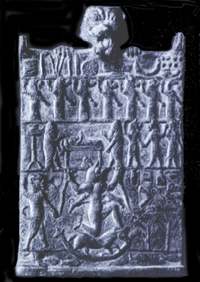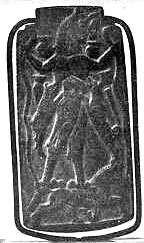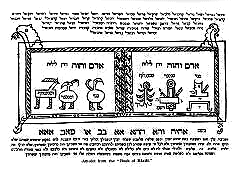|
Neo-Vampire Gods, Demons, and Faeries
from
Strigoi'sTomb Website
recovered trough
WayBackMachine Website
 
The photo directly above is an enlarged image of the Babylonian demi-Goddess
Lamastu. She is kneeling on the back of a donkey in a
boat on the river of the Underworld. She is lion-headed and holds a
snake in each hand. A piglet sucks upon her left breast while a
whelp or puppy sucks on the right breast. In the space between her
legs and the neck of the donkey is a scorpion. The bow of the boat
ends in a snake’s head. This enlarged image is a detail from the
bronze plaque shown on the lower right.
 The bronze plaque on the
right shows Lamastu being forced back
into the underworld by the demon-God Pazuzu. The figure at the lower
left corner of the plaque, to the left of Lamstu, is that of Pazuzu.
The head at the very top of the plaque is also that of Pazuzu. In
the tier directly above Lamastu, priests are treating a sick person
lying on bier. On the tier directly above that are more standing
images of Pazuzu. The bronze plaque on the
right shows Lamastu being forced back
into the underworld by the demon-God Pazuzu. The figure at the lower
left corner of the plaque, to the left of Lamstu, is that of Pazuzu.
The head at the very top of the plaque is also that of Pazuzu. In
the tier directly above Lamastu, priests are treating a sick person
lying on bier. On the tier directly above that are more standing
images of Pazuzu.
Vampiric Demi-Gods and Demons of Ancient Mesopotamia
In ancient Babylonian and Assyrian mythology, the male lilu and the
female lilitu are demons who haunt deserts and are especially a
threat to infants and pregnant women. The ardat-lili is a demonic
female who causes men to be impotent and women to be sterile.
Babylonians and Assyrians also believed in the demi-Goddess Lamastu
who especially preyed upon infants and women in labor. Slithering
quietly like as snake into a home, she could snatch a baby out of
the womb or out of its cradle. She also could also inflict disease
upon both men and women. Her father is the primordial sky-God Anu,
the prime-mover at the beginning of creation, who took over Heaven
and separated it from Earth.
Pazuzu is the king of the wind-demons. Although his own reputation
is rather dark, he was invoked on amulets to protect against
Lamatsu. Pregnant women sometimes wore a bronze head of Pazuzu on a
necklace for this purpose.
The photo directly below is that of an amulet depicting Lamastu. Her
image is closely similar to the image of Lamastu in the plaque shown
above. But here she is standing on the donkey, and her feet,
resembling the talons of a bird of prey, can be seen.
 
Directly above is the reduced image of an amulet from a copy of the
rare Hebrew
Book of Raziel at the British Museum in London. Amulets
made in this pattern were worn by pregnant women and the newborn as
protection against Lilith. The three images on the right side are
the seals of, left to right, the angels Senoi, Sansenoi, and
Samangeloph who protect such women and their newborn against
Lilith
if they wear such an amulet. The three figures on the right
symbolize, left to right, Adam, Eve, and Lilith. A fuller sized
reproduction can be found in Amulets and Superstitions by E. A.
Wallis Budge, originally published in 1930 by Oxford University and
currently re-printed by Dover.
Lilith
In Jewish lore, Lilith is a female spirit of the night who, like a
succubus seduces men while they are sleeping, causing them to emit
semen which she takes to breed children of her own; she also
strangles human infants during or after their birth. Her female
offspring are called Lilim.
 It seems very likely that Lilith was adopted from
Mesopotamian
beliefs by the Hebrews during their Babylonian Captivity. It seems very likely that Lilith was adopted from
Mesopotamian
beliefs by the Hebrews during their Babylonian Captivity.
In the Talmud, Lilith is only described as being a threat to "men
who sleep alone", and it is said here that after Adam left Eve for
one hundred thirty years and from the semen he emitted accidentally
there was begot "ghosts and male demons and female night demons, or Lilim." (I base this on excerpts from Hebrew-English edition of the
The Babylonian Talmud edited by Rabbi I. Epstein (Socino Press,
1978) that are quoted on page ix of The Book of Lilith by Barbara Koltov (Nicholas-Hays, 1986))
In The Alpha Bet of Ben Sirah written at some time between 600 CE
and 1100 CE, Lilith is said to be the first wife of Adam, made from
dust like him. When she demanded equality with Adam and he refused,
she retired to a cave where she consorted with demons and gave birth
to demonic children. Adam complained to God about Lilith’s
departure. God then sent three angels named Senoy, Sansenoy, and
Semangolef. to bring her back to Adam.
These angels found her in her
cave and threatened that, unless she went back to Adam, she would
lose a hundred of her demonic children daily by death. But Lilith
preferred this punishment to living with Adam. She takes her revenge
by injuring or killing human infants and young children. The three
angels only stopped harassing her when she swore that, whenever she
saw the names and images of these angels in an amulet worn by or
near to a child, she would not harm the child.
Back to Contents
|


 The bronze plaque on the
right shows Lamastu being forced back
into the underworld by the demon-God Pazuzu. The figure at the lower
left corner of the plaque, to the left of Lamstu, is that of Pazuzu.
The head at the very top of the plaque is also that of Pazuzu. In
the tier directly above Lamastu, priests are treating a sick person
lying on bier. On the tier directly above that are more standing
images of Pazuzu.
The bronze plaque on the
right shows Lamastu being forced back
into the underworld by the demon-God Pazuzu. The figure at the lower
left corner of the plaque, to the left of Lamstu, is that of Pazuzu.
The head at the very top of the plaque is also that of Pazuzu. In
the tier directly above Lamastu, priests are treating a sick person
lying on bier. On the tier directly above that are more standing
images of Pazuzu. 

 It seems very likely that Lilith was adopted from
Mesopotamian
beliefs by the Hebrews during their Babylonian Captivity.
It seems very likely that Lilith was adopted from
Mesopotamian
beliefs by the Hebrews during their Babylonian Captivity.